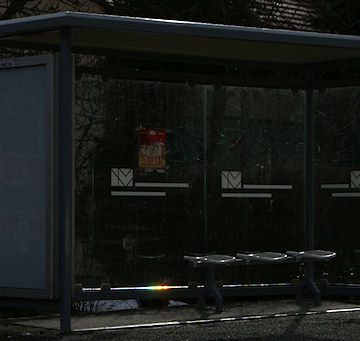NEW AND IMPROVED: Turn your iPhone or iPod into a field-tested global satellite tracker. The Satellite Flybys app now works in all countries. | | | SPECTACULAR ERUPTION: A spectaular eruption is underway on the sun. SOHO is tracking a bright CME billowing upward from the vicinity of the sun's north pole: movie. Imagery from NASA's STEREO spacecraft show that this is a farside eruption, tilted away from Earth. Stay tuned for updates. SOLAR CONJUNCTION: Looking for Jupiter? Don't. Today, the giant planet is only a fraction of a degree from the blinding sun. Astronomers call such a close encounter a "solar conjunction." Human eyes can't see the event, but the Solar and Heliospheric Observatory (SOHO) can using a coronagraph to block the glare: image. Join SOHO for a ringside seat. SNOW MOON: There's a full Moon tonight (Feb. 28th @ 1638 UT) and according to folklore it has a special name--the "Snow Moon." Here it is (almost full on Saturday) rising over a farmstead in Albany, Missouri: 
"I took the picture using my Nikon D90," says Dan Bush. "It was a beautiful scene." The Snow Moon gets its name from the heavy snows of February. When moonlight hits that widespread blanket of white--wow!--the silvery glow hits you from both directions in a luminous blast that seems to exceed any other full Moon of the year. Got snow? Check it out. more images: from Martin Popek of Nýdek, Czech republic; from Tamas Ladanyi of Lake Balaton, Hungary; from Constantinos Emmanouilidis of Alikes, Volos, Greece NOVEL USE OF A BUS STOP: In what appears to be an all-time first, nature photographer Monika Landy-Gyebnar of Veszprem, Hungary, has pioneered the use of a roadside bus stop as a solar spectroscope. "I was photographing a very intense halo display yesterday when I noticed a colorful flash from the corner of my eyes," Landy-Gyebnar. "It was coming from a bus stop across the street." Click on the image and take a closer look at the spectrum running along the bottom of the structure's cut-glass walls: 
Beveled edges outlining the bus stop's glass sides acted like a high-dispersion prism, spreading the colors of sunlight into a broad line for easy inspection. The relevant cuts are diagrammed here. The dark gaps in the spectrum are real. They are Fraunhofer lines, named after the German physicist Joseph von Fraunhofer who studied them in the 18th century. Fraunhofer lines are imprinted on the sun's spectrum by cool gases in the sun's atmosphere, which absorb light from the hot stellar surface below. Each color corresponds to a specific element. The double-yellow lines caused by sodium, for instance, are particularly obvious in the bus-stop spectrum. Fraunhofer lines have been used to study the chemical make-up of stars for more than two hundred years. Of all the stars in the heavens, however, only the sun is bright enough to show its spectrum in the corner of a bus stop. It's something to look for while you're waiting for a ride.
February Northern Lights Gallery
[previous Februarys: 2009, 2008, 2007, 2006, 2004, 2003, 2002] | 
